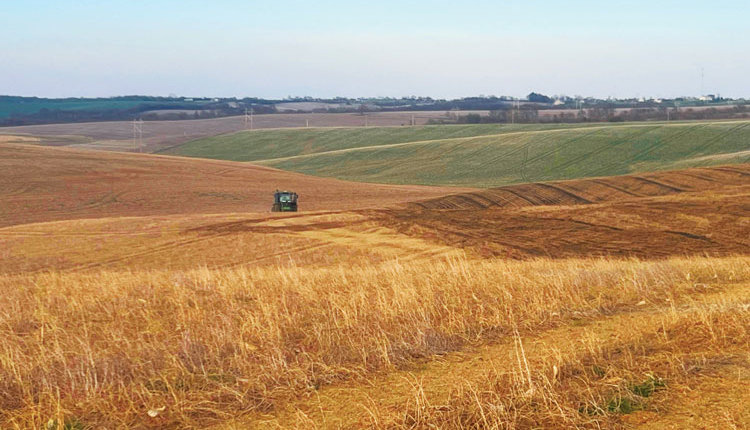
Sustainability has long been a foundation on farms of all types and sizes. While sustainability may not have always involved carbon sequestration for the carbon market or goals of reduced greenhouse gas emissions, farmers have been conservationists for hundreds of years.
Soil conservation and nutrient management are critical for maintaining land for the next generation. The main components of nutrient management create a factual, model-based story of sustainability that will aid in the preservation of farming far into the future. Key industry stakeholders are already using nutrient management as a measure of sustainability. Where does the nutrient management planning process intersect with the vital portions of this somewhat new objective of sustainable farming?
It starts with soil
It takes about 500 years to form one inch of topsoil, so any farmer can see the value in protecting the soil while also taking measures to help regenerate it. Tolerable soil loss (T) is the metric used to determine the severity of soil loss. Tolerable soil loss levels range from as low as 1 ton per acre per year to as high as 5 tons per acre per year. These tolerable losses vary based on a soil’s tolerance to erosion. Soil that is easily eroded will have a very low tolerable soil loss, while soil that resists erosion well will have a higher T value. Additionally, soils that have already experienced erosion will have lower tolerable soil loss values. Without bringing soil loss below tolerable levels, there is no sustainability of a farm’s soil.
Soil loss through water erosion is measured in tons per acre per year using the Revised Universal Soil Loss Equation 2 (RUSLE2). RUSLE2 uses factors such as slope percent and length, as well as soil type, rainfall, and runoff to estimate soil loss throughout the crop rotation. While producers can’t change the soil type or the slope, they can influence the erosion rate by managing the amount of tillage, changing the crop rotation, or adding cover crops.
Water on the surface
When soil is conventionally tilled, the bare soil is exposed to every drop of rainfall on its surface. It is this initial rain drop impact that has the greatest impact on soil erosion. When a raindrop hits the soil surface, it detaches soil particles and suspends them in the water. This suspended soil in the water droplet moves with the runoff across the soil surface and potentially off of the field. When cover crops or reduced tillage are used, the soil is protected from rainfall’s impact by an armor of dead or living plant material.
Beyond soil loss, water’s effect on the land also influences phosphorous loss. Unlike nitrogen, which leaches through the soil, phosphorus nutrients are tightly bound to the soil. When soil is detached from the field, it brings phosphorus along for the ride. Unfortunately, this is the leading cause of eutrophication in freshwater, causing algae blooms in lakes and streams.
The Phosphorus Index is the measure used to estimate the risk of phosphorus delivery to surface water. A unitless measure, the index’s magic number is six — but the lower, the better. Anything above six is considered a high risk.
The best option for farms to reduce their P index value is through the reduction of soil test phosphorus (STP) to optimum levels. When the concentration of phosphorus in soil is high, the amount of phosphorus lost through erosion is also high.
Support from stakeholders
While several sustainability projects, grants, and their subsequent funding appear to be in limbo, the collective goal and drive toward sustainability have not changed. Industry stakeholders will continue their push — especially as consumers drive the food directive.
Currently, there are multiple incentives for farms to adopt management practices that further the sustainability goal. Some dairy food plants offer bonuses for completing a nutrient management plan. Similarly, some ethanol and other grain buying markets provide per-acre or per-bushel incentives on grain grown with a smaller carbon footprint.
Having a nutrient management plan is often a payment enhancer as well as a great way to track field or farm history. In addition, some county governments are offering tax incentives for landowners with nutrient management plans on their farms. Soil carbon credits and carbon trading for the carbon market are still much easier to broker when nutrient management plans are included to qualify the farm for this opportunity. The state and federal government still require NMPs for concentrated animal feeding operations (CAFOs).
Seek out resources
Farms of any size can take advantage of a wide array of sustainability, conservation, and nutrient management resources. The federal government maintains its core programs of the Environmental Quality Incentives Program (EQIP) and the Conservation Stewardship Program (CSP). Through either program, payments are available for writing a nutrient management plan and participating in sustainability enhancing activities like those previously mentioned. If sustainable practices are already on your radar, explore options for funding that USDA can provide.
With or without a current nutrient management plan, farms can begin incorporating regenerative practices into their management scheme. Whether writing your own plan or hiring a professional adviser, a nutrient management plan can be a giant leap in the right direction. The additional validation and documentation that a plan provides will help a farm ensure compliance with mandatory programs or voluntary incentives that may appear. Even without a program incentive, having a plan will ensure that farmland will sustain and support future generations.
This article appeared in the May 2025 issue of Journal of Nutrient Management on page 12-13.
Not a subscriber? Click to get the print magazine.









